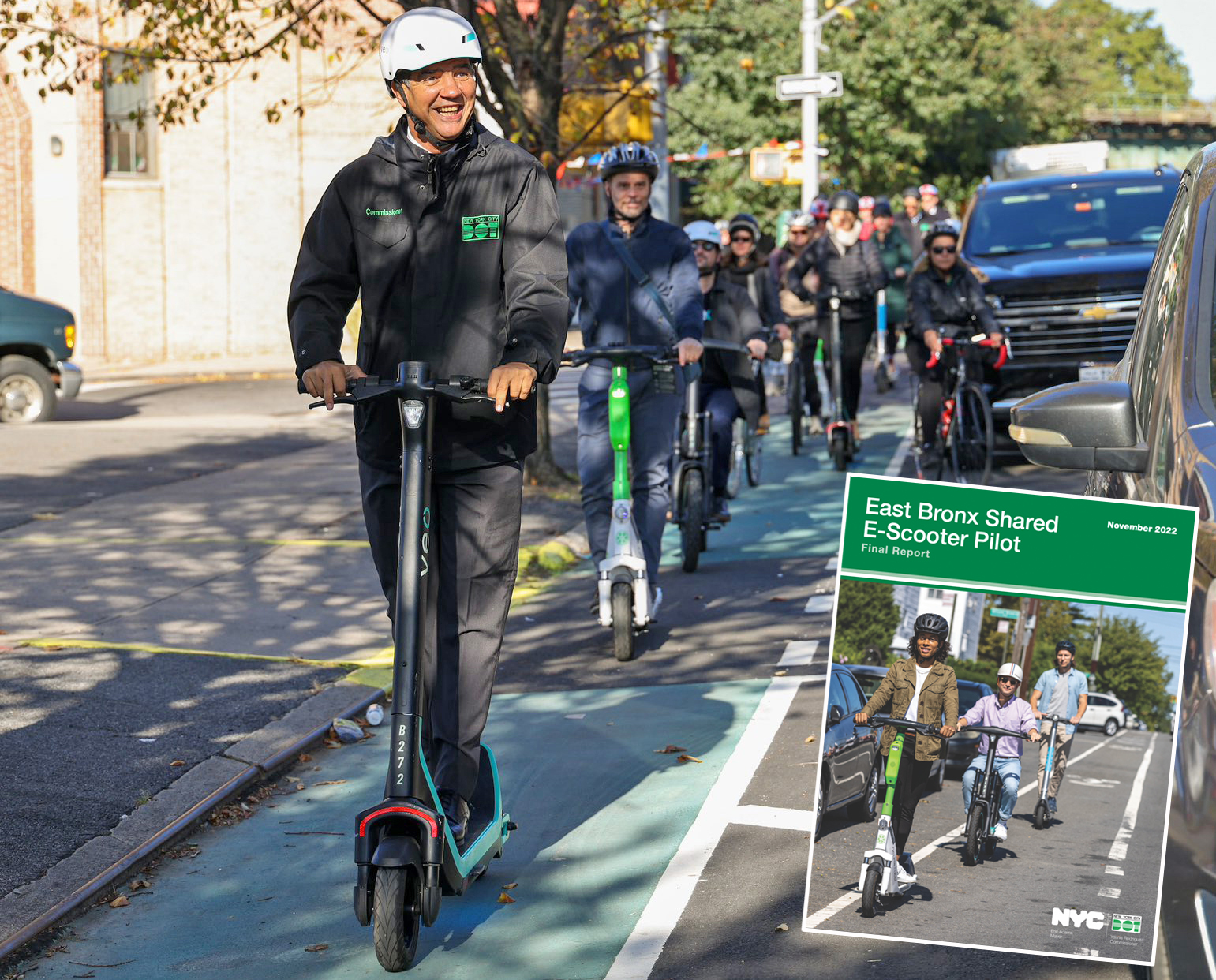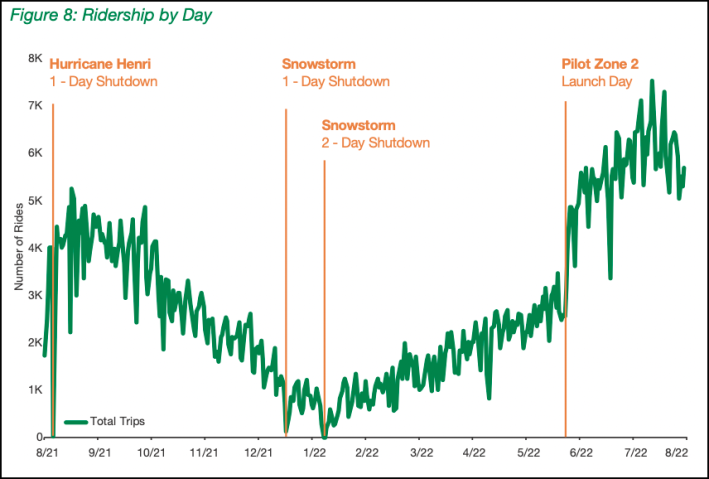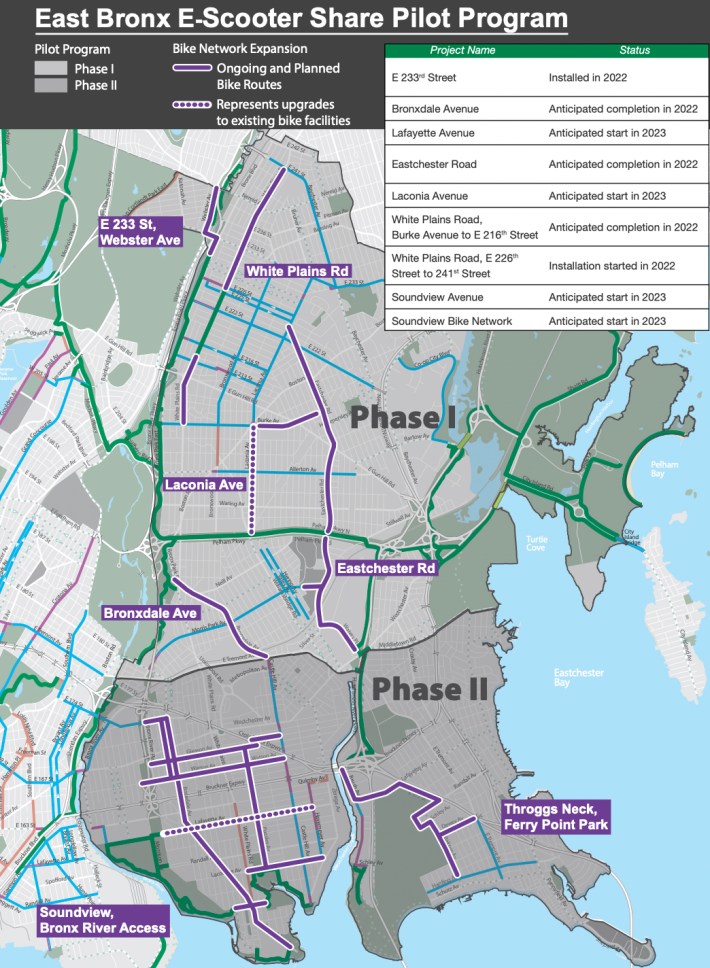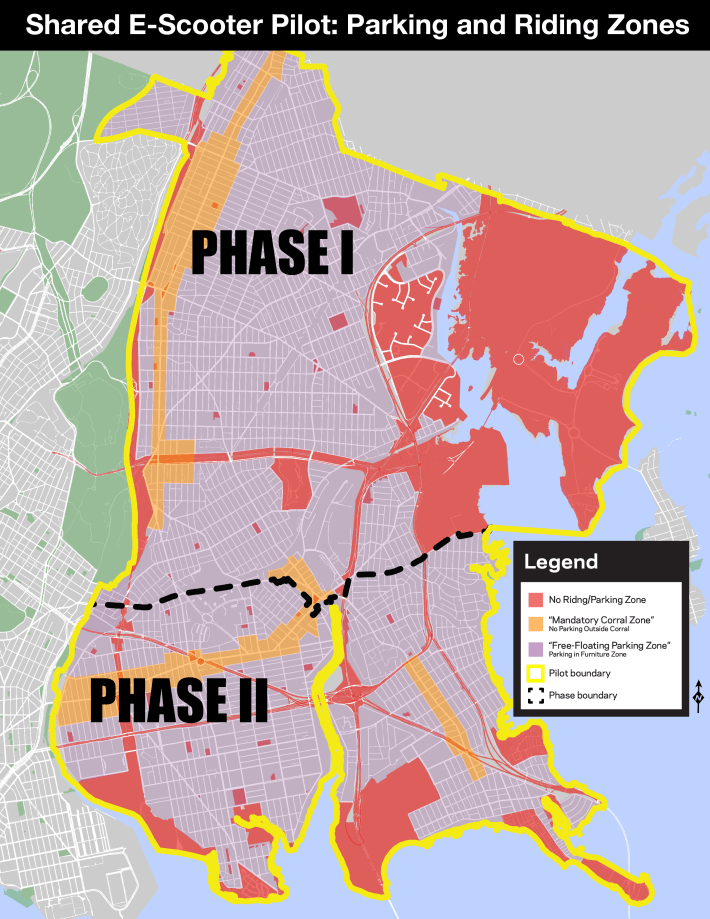Bronx Scooter Pilot to Become Permanent — And Likely Expand
12:53 PM EST on November 14, 2022

DOT Commissioner Ydanis Rodriguez recently rode a scooter on the new Bronxdale Avenue bike lane. File photo: DOT
The universe (of scooters) is expanding.
The Department of Transportation dropped two bombshells on Monday — that their Bronx e-scooter pilot has been a huge safety and transportation success and that the agency wants to make it permanent next year and possibly expand it city-wide to "communities underserved by existing transit and micro-mobility services."
Three companies — Veo, Bird and Lime — have been operating 2,000-vehicle fleets in the East Bronx since the scooter share pilot began in August 2021 and then was expanded to a larger area in June (see map, right).
In a report timed to the release of the request for proposals, DOT said the companies have been operating safely and successfully.
The companies served 86,000 riders, who took more than 1,000,000 trips in 12 months, the report said, with the highest ridership on weekdays, evidence that scooter-share is aiding in commutes.
"Ridership was high on commercial corridors and near MTA transit, including subway stations, bus and ferry stops," the report showed.
There have also been no fatalities, which the report credited to some key safety features that were required under the pilot — such as speed limits and no overnight use for new riders.
Another huge upside: "Discounted-pricing participants completed an average of 25 trips versus the system-wide average of 11 trips," the report said of the program's required discounts for people living in public housing.
One flaw in the system, however, is that "knowledge of, and participation in, the discounted program, however, was low."
Another flaw is the way in which the companies use existing technology to keep scooters off of sidewalks, the report conceded: "Shared e-scooter operator GPS is currently too imprecise to implement some policies effectively. Creating a system that consistently provides high quality user experience and upholds rules has proven to be resource intensive and an iterative process."
As a result, scooters are not always left where they should be. "During DOT inspections, 24 percent of all inspected e-scooters were improperly parked," the report said.
But ridership is promising, with trips averaging roughly 10 minutes:

One red flag: When the DOT surveyed scooter riders, the agency discovered that scooters are mostly replacing walking or transit trips, rather than car trips. Not all the users responded to the survey, but the agency did conclude that "shared e-scooters were less likely to replace motor vehicle trips" than walking or transit use. Reducing driving is a key benefit hyped by scooter operators and has shown some promise, according to academic research.
The vast majority of scooter users in the Bronx (59 percent) took fewer than four trips during the year-long study area. But 10 percent did take more than 25 trips. And complaints about the scooters (from users and non-users) never exceeded 4 percent of any given month's rides. By the end of the study period in August, overall complaints were down to 1.3 percent of that month's rides.
Perhaps the most interesting finding is where trips are originating and ending. It's clear from the map below (and an almost-identical one of destinations) that many riders use scooters to get to or from key subway stops. As the report says:
Four neighborhoods saw nearly half of all trip starts during the first 12 months of the pilot: Van Nest-Morris Park-Westchester Square had the highest share of all trip starts with 15 percent, followed by Williamsbridge-Olinville (12 percent), Pelham Parkway (11 percent), and Eastchester-Edenwald-Baychester (10 percent).
Highlighting early successes in Phase 2, the Soundview-Castle Hill-Clason Point-Harding Park neighborhood at the southern end of the service area had the highest share of trip starts in July 2022 with 13 percent of the month’s trips. In addition, as visualized in Map 4 and Map 5, some of the highest ridership corridors connected riders to MTA transit service and commercial activities.
Morris Park Avenue, a commercial corridor in the Morris Park neighborhood, had the highest number of e-scooter trips. The corridor has a conventional bicycle lane in both directions as well as access to the 2 and 5 subway lines and two buses. The eastern end of Morris Park Ave is home to Yeshiva University, Albert Einstein College of Medicine, the Montefiore Medical Center, and the Jacobi Medical Center. Other corridors with high trip volumes included White Plains Road, Boston Road, East Gun Hill Road, and Williamsbridge Road. Of these three roads, only a portion of White Plains Road has a bike facility, highlighting potential demand for additional infrastructure improvements on major corridors. The first month of service in Phase 2 showed that Castle Hill Ave, White Plains Road, Westchester Avenue, and East Tremont Avenue are popular routes in the southern section of the service area.
Phil Jones, the senior director for government relations at Lime, said the report made it clear that "The Bronx loves e-scooters."
He suggested that the company will bid to run the program: "We look forward to continuing to serve the Bronx and the opportunity to expand to new neighborhoods that will benefit from last and first mile transit connectivity."
Meanwhile, Bird may find itself unable to compete. The company overstated its scooter revenue for at least two years, the company told the Securities and Exchange Commission on Monday, the Verge reported. (The company did not respond to our email seeking comment.)
Going forward, the DOT says it is seeking the following goals from the five-plus-year contract (read the full request-for-proposals below):
- Mobility: expand convenient, affordable, and sustainable mobility options for New Yorkers, initially for those residents living in communities underserved by existing transit and micro-mobility services. (It's fair to point out that one such area is City Island, which has nonetheless been excluded from the Bronx pilot.)
- Safety: ensure that the Program is safe for riders, pedestrians, and other street users and supports New York City’s Vision Zero commitments.
- Accessibility: ensure that program does not impede travel on sidewalks; explore a range of accessible options and features for people with a range of disabilities.
- Equitable access: expand mobility options for low-income New Yorkers and for communities underserved by transit and [Citi Bike].
- Transparency and Accountability: minimize adverse impacts on residents and ensure transparency about operators’ performance.
- Fair labor practices: ensure that contractor’s treat their employees and contractors respectfully and fairly.
- Consumer protection: ensure that the rider data is protected and that riders have access to redress through the courts.

But that leaves some questions, including, most important, where will scooters expand (they are only barred in Manhattan, and many areas of the city qualify as "communities underserved by existing transit and micro-mobility services")?
Left unsaid in the RFP are such things as when the Bronx's bike and scooter infrastructure expansion will be done (see map, left), how many applicants (if more than one) will be chosen, and what a ride will cost. Ten percent of the evaluation criteria is the applicant's proposed pricing scheme, but the largest portion of that criteria — 55 percent — is an applicant's "quality of proposed approach."
Currently, all the companies charge $1 to unlock a scooter and 38 or 39 cents for each minute in use, meaning a 10-minute scooter ride costs just under $5.
The RFP doesn't seek fly-by-night companies, with the requirement that applicants must have "been in operation for a minimum of two full years; and have experience with providing municipalities of a similar size and complexity as New York City with comprehensive and safe Micro-mobility Services, including a range of devices."
The program will run on its current pilot basis until the new contract takes effect on Aug. 24, 2023, the DOT said. Proposals are due on Dec. 22.
The news also came as the DOT announced that it had begun construction on dedicated bus lanes on Northern Boulevard in Queens, starting on 114th Street and working westbound over the next few weeks.
Today, NYC DOT will begin #BetterBuses improvements on Northern Blvd beginning at 114th St and moving westbound in #Queens. This work will:
— NYC DOT (@NYC_DOT) November 14, 2022
🚌Increase bus speeds
🚗Improve roadway organization
🚦Signal timing improvements
🚍Transit signal priority pic.twitter.com/C5UsV8gyAw
NYC DOT Micromobility RFP Document by Gersh Kuntzman on Scribd
Gersh Kuntzman is editor in chief of Streetsblog NYC and Streetsblog USA. He also writes the Cycle of Rage column, which is archived here.
Read More:
Stay in touch
Sign up for our free newsletter
More from Streetsblog New York City
Stockholm Leader’s Message to NYC: ‘Congestion Pricing Just Works’
"In Stockholm, people really thought that congestion pricing would be the end of the world, the city will come to a standstill, no one would be able to get to work anymore and all the theaters and shops would just go bankrupt. None of that happened."
Friday’s Headlines: Trump Trial Trumps Safety Edition
Is anyone going to bother to fix the dangerous mess on the streets and plazas around the Trump trial? Plus more news.
Adams Offers Bare Minimum to Seize Congestion Pricing’s ‘Space Dividend’ Opportunity
The mayor's list of projects supposedly meant to harness congestion pricing's expected reduction in traffic is mostly old news, according to critics.
OPINION: Congestion Pricing Will Help My Family Get Around As We Navigate Cancer Treatment
My partner was recently diagnosed with cancer. Congestion pricing will make getting her to treatment faster and easier.






